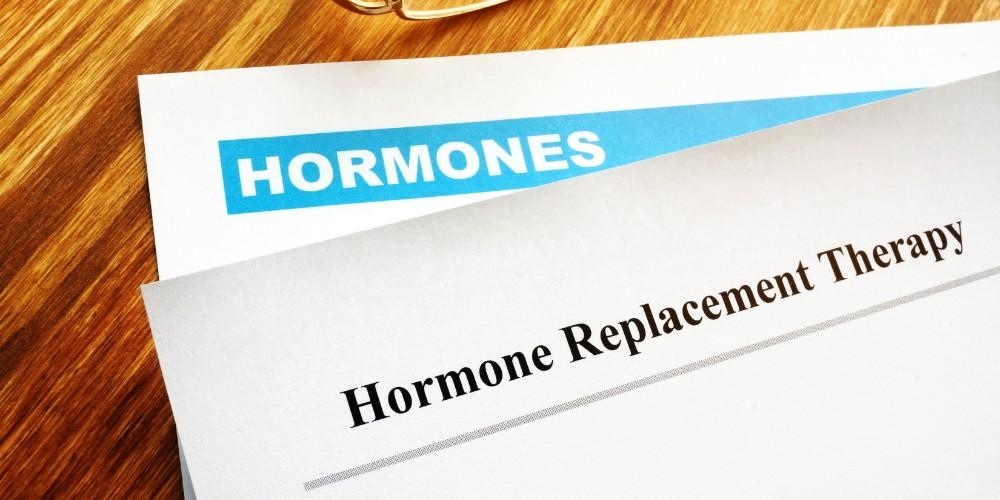As men slowly transition into the andropause phase, they may experience a decrease in testosterone levels. As these changes occur, new uncomfortable symptoms start to show. For men, the decrease in testosterone production may involve low energy levels, brain fog, decreased libido, E.D. (erectile dysfunction), and weight gain around the midsection. Because these symptoms can signal many other conditions, a healthcare provider would order lab tests to see if low testosterone is the cause of these maladies. Depending on the severity of the symptoms and how much they get in the way of daily life, you might consider discussing hormone replacement therapy with your practitioner to see if it is a viable option for you.
What is Hormone Replacement Therapy?

When people go through this period of change, hormone replacement therapy, or specifically testosterone replacement therapy, can help boost the hormone levels, relieving some of the andropause symptoms. The hormones can be administered in one of several ways, such as injections, pills, patches, topical creams, or gels. Most often, HRT (hormone replacement therapy) is used to treat a specific condition under the watchful care of a healthcare provider. One such condition in men is hypogonadism which drastically hinders the body’s ability to produce testosterone. This problem stems from either the pituitary gland or the testicles. In this case, HRT is the most common treatment.
Of course, family, and personal medical history, age, and severity of the symptoms are just some of the factors that can affect your decision towards taking or not taking hormone therapy. As such, talking with a healthcare professional about both hormone replacement therapy benefits and risks is highly recommended.
Types of Hormone Replacement Therapy
The two main hormones used during hormone therapy specifically for men are testosterone and hCG. However, the two are not used in conjunction with each other.
Testosterone Therapy
As mentioned, if your testosterone levels have dropped, there are therapeutic options available in different forms that can be administered via injection or ingested, or given in a topical form. This type of therapy is only available with a prescription from a healthcare provider.
hCG Treatment
For men who suffer from low testosterone levels but still want to maintain their fertility, hCG is given as part of the testosterone therapy. The doses are accompanied with Clomid, which is also a fertility drug. This combination of hormones can boost testosterone production on its own. However, if a patient has an extremely low testosterone level, then he might receive very low doses of testosterone and afterward change over to the hCG alternative.
Which Type of Hormone Therapy is Right for Me?
There will be many factors to be considered when deciding what the right hormone treatment is. Starting from the age, risks that can occur based on personal and family health history, personal preferences, available treatment options in the area, and also the cost of that particular treatment. Having in-depth consultation with a clinician and understanding the choices as well as what are the upcoming benefits against the risks – all that must be checked before making the final decision.
How is Hormone Replacement Therapy Administered

Hormone replacement therapy can be prescribed in several different forms The one your practitioner chooses depends on your condition along with benefits and risks.
Tablets
Taken once a day, this is the simplest way to follow this treatment. Both types of therapies are available in this form. Though, it is important to know that blood clots, although in a small percentage, can present a higher risk in this form than any other.
Skin patches
Another easy and common way to follow the treatment. As the skin patch needs to be replaced every few days, this form might be an even better option compared to tablets. Available for both forms of hormone replacement therapies, using patches does not create indigestion and even helps lower the risk of blood clots.
Testosterone gel or cream
Another popular form, which is applied topically daily.
Also, testosterone can be given in the form of pellets that go under the skin or injections. Specifically, at the Apollo T Center, the treatment is given via IM or intramuscular injection in which the hormone is delivered deep in the muscle tissue. This method allows for more efficient absorption into the bloodstream.
What are the Risks of HRT?
Hormone replacement therapy, unfortunately, does not come without risk. Some of the more serious conditions include lower sperm count, sleep apnea (or a worsening of this condition), blood clots, and benign swelling of the prostate. While these risks are not that common, the percentage of some of these risks happening is based on the patient’s age, type of therapy, and health history.
Benefits of Hormone Replacement Therapy

As previously mentioned, hormone therapy can bring about some relief of andropause symptoms like brain fog, lack of energy, E.D., inability to focus, and abdominal weight gain. Besides this, some other benefits that can come out of taking hormone replacement therapy include reduced risk of developing degenerative diseases of the muscle or bone, increased muscle mass, a faster metabolism, improved mood and feelings of wellbeing, and self-confidence.
When Should You Start Taking Hormone Replacement Therapy?

The first thing to remember is there is no “one size fits all” option. Based on individual cases, the idea is to start the hormone therapy with the lowest effective dose for the shortest time possible. While the early 50s present the most common age range where a man starts to notice a decline in testosterone, others have detected a decline as young as their 30s. However, in that scenario, hormone therapy may not be started until after age 40. Because the symptoms and the rate of decline vary from person to person, it’s best to consult with your practitioner before starting hormone therapy and to continue under his or her close supervision.
What is the Duration of Treatment?
The shorter the time, with the lowest dose possible, the better. It is all based on the individual. With that in mind, you can expect to see results in 3 to 6 months. At the same time, some aspects of this condition may take longer than others to improve. For example, your sex drive may improve in a matter of weeks as will your energy level. On the other hand, weight gain may take months or longer to improve which is only normal. So, some patients might start to feel better in 3 to 6 weeks, and others might take longer. Regardless, the treatment is gradual considering that you’ll be starting on the lowest dosage. Plus, continuously monitoring with a healthcare provider and reevaluating the treatment plan yearly offers the best approach.
As you can notice, many things should be considered and tested before taking the final jump. Having a professional on your side is at least one decision you shouldn’t worry about. Apollo T Center performs all necessary preliminary screening for any new patient, plus they record their age, medical history, and current symptoms. When everything is combined, they direct the new patient towards an individualized treatment that helps to bring about the perfect balance of testosterone. Through weekly injections, they ensure the patient is at their best, no matter the stage of the testosterone cycle. And as the testosterone injections bring the body to a balanced state, new energy levels, heightened sex drive, an improved ability to focus and enhanced memory are just a few of the benefits received. If you wish to learn more about Hormone replacement therapy, particularly testosterone therapy, contact Apollo T Center.


